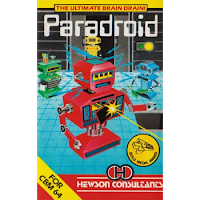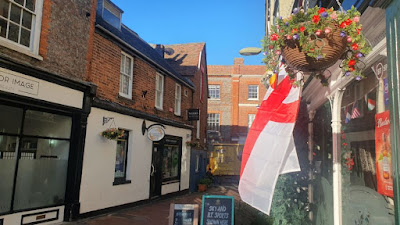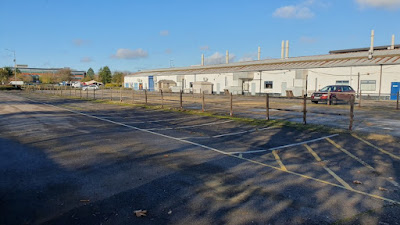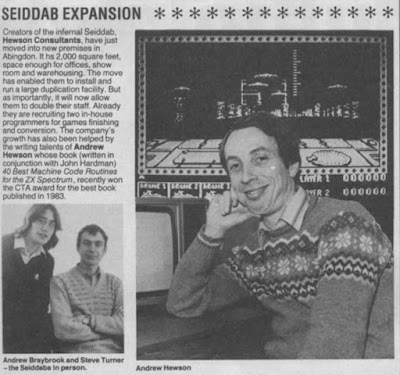56b Milton Trading Estate, Milton, Abingdon, OX14 4RX
 |
7 Grahame Close, Blewbury, OX11
 |
| PERSONAL COMPUTER WORLD December 1980 page 143 |
60A St Mary's Street, Wallingford
Jump ahead to December 1982 and things have changed. Andrew Hewson has become possibly the first celebrity of the Sinclair scene, after Clive Sinclair himself. "Andrew Hewson's books..." is how an advert begins in YOUR COMPUTER, and the blurb for 20 Best Programs for the ZX Spectrum continues: "Mr HELPLINE - the man who answers your ZX queries in his column in Sinclair User, the author of HINTS & TIPS FOR THE ZX8O and HINTS & TIPS FOR THE ZX81 now presents..." Lets rewind and see how we got here.
The ZX Spectrum launched in April 1982. Issue one of SINCLAIR USER was on sale at the same time and Andrew Hewson was there answering readers' technical questions. As he told Anstream.com: "I had a call out of the
blue from a company in London asking me to write a column for a new
magazine called Sinclair User. It was called “Hewson’s Helpline” and it got my name in front of people, and then a steady stream of
cassettes from programmers around the country began to flow my way." Those cassettes would have been coming direct to his house because the contact address for Hewson's Helpline is 7 Grahame Close, rather than via SINCLAIR USER. In fact you could write to Andrew Hewson at home all the way up to issue 71, February 1988. It's fun to note how issue two of SINCLAIR USER describes Andrew Hewson as "the Marjorie Proops of the ZX world." This frivolity doesn't last because SINCLAIR USER isn't that sort of magazine.
 |
| SINCLAIR USER Issue 3, June 1982 |
Two months later, June 1982, and Hewson Consultants have expanded. They've got a new game on offer, Pilot, and more importantly for this blog a new address in Wallingford. A proper office. Wallingford is a nice little market town on the Thames between Reading and Oxford. I approached it along the A4130, an astonishingly boring road to travel down while using Google Maps because the directions are always "in a quarter of a mile, at the roundabout, take the second exit to continue straight. I think I got about nine of those in a row.
 |
| November 2022 |
1983 saw the company consolidate around a trio of programmers. Mike Male, who contributed Nightflite II and Heathrow Air Traffic Control; Kim Topley who wrote the adventure game Quest; and most significantly Steve Turner, who brought 3D Space Wars. Hewson Consultants was, astonishingly, still a part time business for Andrew as he told SINCAIR USER: "It wasn't until
1983 that we seriously believed this hula-hoop craze was strong
enough to build an entire business around. We decided to take it
seriously. I left NERC [Natural Environment
Research Council, a QUANGO*] in mid-83 and by the end of that year we were
bursting out of Wallingford. Shipping out tapes for Christmas was
exciting but also murder."
*QUANGO, yet another acronym. Quasi-Autonomous Non-Governmental Organisation
56b Milton Trading Estate, Milton, Abingdon, OX14
Hewson Consultants became a full time software company a mere three years after being founded. The first thing they did was move to bigger premises on an industrial estate near Didcot. CRASH issue 4 covered the move : "Hewson Consultants have
just moved into new premises in Abingdon. It has 2,000 square feet,
space enough for offices, show room and warehousing. The move has
enabled them to install and run a duplicating facility. But as
importantly, it will now allow them to double their staff. Already
they are recruiting two in-house programmers for games finishing and
conversion."
 |
| November 2022 |
The industrial estate is massive now. Milton Park covers 250 acres and is home to 250 companies and 9000 people working out of glossy and modern offices. What it doesn't have is a 56b. I vacillated for ages about whether to mark Hewson Consultants down as an untracable company. I didn't want to because they were such a key part of the 8-bit scene. I even emailed Milton Park to find out whether they kept any sort of archive but unsurprisingly I didn't get a reply, although I do now seem to be on their mailing list for all eternity.
[WARNING -what follows is speculative and might prove to be very wrong.] If you search Google Maps for 56b Milton Park the little red marker ends up floating over an office block at 60 Jubilee Drive. Switch to Streetview, head down Jubilee Drive towards the junction with Park Drive and you see numbers 59 and 57, followed by a car park. Now, 59 and 57 are both much smaller and older buildings; white-painted single story units with corrugated roofs. They look, dare I say it, quite eighties in style. They are clearly among the oldest buildings on the park, judging by the amount of weathering. They are also occasionally divided into smaller units, for example there is a 59d.
Here's the question, could this be in the vicinity of 56b?
 |
| Imagery ©2023 CNES/ Airbus, Getmapping plc, Infoterra Ltd & Bluesky, Maxer Technologies, The Geoinformation Group, Map data©2023 |
The satellite view shows the sites of similar blocks which have been cleared for car parking space. Right, long story short. If you point Streetview to look at the car park on the corner of Jubilee Avenue and Park Drive and then set the year to 2015, then the building on the corner is still standing. It's unit 56. Proof positive? Not even remotely. All I can say is, the units are the right sort of size (about 20 feet by 100 feet, matching the 2000 square feet in the CRASH news story) and don't contradict any of the limited information I've been able to gather about Hewson's building. But only Andrew Hewson knows for sure.
So I drove to Milton Park and took a picture of the nearly empty overflow car park where building 56 used to stand.
 |
| November 2022 |
This might be the daftest thing I've done for this blog, so far. Fortunately it's not a contest.
From Milton Park, Hewson Consultants released, courtesy of Steve Turner and Andrew Braybrook of Graftgold, some of the most outstanding games for the Commodore 64 and ZX Spectrum; Avalon and its sequel Dragontorc of Avalon, Paradroid, Uridium, and Quazatron. Hewson also worked with other top programmers like Steve Crow, (Firelord), Raffaele Cecco (Cybernoid and Stormlord), Dominic Robinson (Zynaps, Ranarama), and more. I could just keep listing Hewson titles like Nebulus, Iridis Alpha, and Pyracurse, because they are all innovative and original games.
It wasn't all plane sailing. Graftgold and Hewson unexpectedly split in 1987, when Steve Turner and Andrew Braybrook were lured to Telecomsoft's Firebird label. POPULAR COMPUTING WEEKLY (2-8 October 1987 page 5) reported: "A source very close to
both Hewson and Telecomsoft suggested that the deal was first
suggested less than a week ago, and that both Braybrook and Turner
were convinced in only a matter of hours that Telecomsoft could
provide a more stable and profitable base than Hewson, One of the
main reasons, it seems, that Graftgold was unhappy with Hewson was
the lack of any sort of formal contract". Steve Turner, in an interview with retrovideogamer.co.uk, later recalled: "Our original
relationship with Hewson was really good at first as we were left to
create and he did the publishing. The trouble was we did not get
advances so later on when programs took longer to write it put all
the risk on us." Hewson expected to be releasing Magnetron and Morpheus for Christmas 1987 and had even begun advertising them. The dispute went to court and in December 1987 a preliminary ruling found that Telecomsoft could release the two titles. Andrew Hewson understandably felt hard done by, and told POPULAR COMPUTING WEEKLY: "I'm pig-sick about it... Money talks. The truth is BT could buy the
whole of this market tomorrow if they felt like it. That's what
financial clout is all about."
Hewson struggled when the market shifted to 16-bit computers, as Andrew told antstream.com, "A number of our titles
were ported, but we didn’t have anything new coming through which
captured the potential of the new machine as we did at the dawn of
the 8-bit era." Hewson found a new revenue stream by licencing back catalogue games to magazine cover disks, and more income came from licencing Stormlord to US company Razorsoft for the SEGA Genesis, but it couldn't last. The company entered receivership in early 1991 as Andrew told retrogamegeeks.co.uk: "Costs were going up,
our overdraft was growing and then our German distributor dropped a
bombshell on us by saying they couldn’t pay what they owed. I
personally felt a weight of responsibility for the people who worked
for me and we decided the right thing to do was to close. In
hindsight we probably could have ploughed on and recovered, but I was
feeling very emotionally drained by this point." Except that wasn't the end. Speaking to retrogamesmaster.co.uk Andrew recalled: "I
was at a social event in my village a couple of weeks after Hewson
had closed when a friend came up to me and said 'how much would it
take to restart this thing?'. It came out of the blue but I gave
him a number and he said 'that doesn’t sound like too much'. The story is picked up in the retrovideogamer.co.uk interview: "he raised the finance and a
support team (which is what I really needed). Suddenly we were back
in business."
Hewson Consultants picked up the pieces exactly where they were dropped and moved back into 56b Milton Trading Estate but one thing was different. The name. Hewson Consultants became 21st Century
Entertainment. It was a shame to lose the eleven year history associated with the Hewson Consultants name but even in the mid-eighties it was a slightly stuffy and outdated name for a company and was only used because, "Hewson Consultants was the trading name I used when I did some consultancy work in the late 1970s," retrovideogamer.co.uk. A revived Hewson Consultants could have been a success in much the same way Ocean resurrected the Imagine brand, but the old name would carry too much continuity. In more recent interviews Andrew Hewson hints that, although he has tremendous nostalgia for what he achieved, the actual running of the company was a draining slog, with the release of Uridium being a particular turning point.
retrogamesmaster.co.uk: "For me the enjoyment began to melt away towards the end, so the earlier games are the ones I was most excited about, back when everything was new. Avalon was a revelation, Uridium for our biggest hit, but it also marked the beginning a dawning realisation that the future was going to be difficult."
anstream.com: "After we shipped
Uridium in 1986, which was by far our biggest hit, I remember
slumping onto the sofa and falling into an emotional pit. It had been
such a colossal effort and it was such an exceptional game, that I
simply couldn’t believe we could possibly replicate the success. A
year later it was beginning to dawn on me that the business model was
not sustainable because the ever-escalating costs of producing a hit
game could not be covered by the profits which were, of course, being
plundered by rampant piracy. But I was too inexperienced to do
anything about it, and I didn’t have anybody with business acumen
to turn to for support, so we drove on as best we could." With all this in mind it's not surprising the company name changed; a new direction, a fresh start, and so on.
21st Century Entertainment hit its stride in 1992 when Andrew Hewson met four Swedish students and released their game Pinball Dreams. The Swedish students went off to form Digital Illusions and became tremendously successful. Digital Illusions became DICE (Digital Illusions Creative Entertainment), and was acquired by Electronic Arts (or EA as they prefer to be known in this funky world of corporate initials), and are based in Stockholm so fall somewhat outside of the scope of this blog. 21st Century Entertainment followed Pinball Dreams with Pinball Fantasies, Pinball Dreams II, Pinball Arcade, Pinball Illusions and other pinball games. "In later years I
realised that you needed to develop a niche," Andrew Hewson told retrovideogamer.co.uk.
Westbrook St, Blewbury,
Oxfordshire, OX11
21st Century Entertainment returned to Andrew Hewson's home town around 1993. Mobygames lists Blewbury as a company address for 21st Century Entertainment and this is confirmed by a small article in AMIGA USER INTERNATIONAL.
 |
| AMIGA USER INTERNATIONAL November 1993 page 18 |
It's a charming piece about the release of Andrew Hewson's 200th title, Pinball Dreams, and shows him posed in front of framed cover art for Nebulus, Technician Ted, Pinball Dreams, and Pinball Fantasies. In terms of expressions, I think he's aiming for "thoughtful" but he accidentally hits "slightly fed up". An archived 1994 interview from GAME BYTES MAGAZINE describes the 21st Century Entertainment offices as, "a modest collection of
pre-fabricated buildings tucked away in the picture- postcard village
of Blewbury located in the rolling countryside 15 miles (25 km) south
of Oxford." 21st Century Entertainment was wrapped up in either 1998 (Wikipedia) or 2001 (Companies House). They really deserve their own article but, as the question over the date of their closure shows, it gets harder to track companies through the nineties and early two thousands. Ironically, there's less accessible information for this period. Future Publishing, who became the dominant force in magazines, guard their copyright carefully so fewer magazines are archived; companies were advertising a lot less in this period and, when they did, postal addresses were used much less often; and corporate websites have long gone. The Wayback Machine does record hits for the 21st Century Entertainment website, the earliest dating to 23rd October 1996, but this is the American office based in Webster, New York.
Andrew Hewson wrote another book in 2016, Hints & Tips for
Videogame Pioneers, and he's still active on the retro gaming scene, on Twitter and Facebook. His son Rob is CEO and Creative Director of Huey Games.
 |
| "The Hewson team" SINCLAIR USER October 1985 page 108 |
EA DICE are based at 104
60, Södermalmsallén 36, 118 28 Stockholm, Sweden, take a picture and email it to whereweretheynow@gmail.com. If you live in Stockholm, obviously. Please don't go making a a special journey if you live outside of Stockholm. I cannot pay travel expenses. Residents of Webster, New York, I'd happily accept a picture of the old 21st Century Inc office in your town but it's almost certainly unfindable because the postal address was listed as P.O. Box 415.
I'm still on Twitter , to widespread indifference.







I'm sitting right now approx 500m from where Hewson office used to be. It was still here when I first started working on Milton park (2005). Unfortunately it was knocked down between 2016-2017 and is now an overflow car park. It was in the row of huts closest to Park Drive. If you use google street view and go back in time (yes you can do that) to 2016 or earlier you can see it. I have some pictures somewhere I sent to Andrew Hewson for his book (which I don't think they used).
ReplyDeleteI'd be really interested to find out more about your photos of the old Hewson offices. Could you email me at whereweretheynow@gmail.com
ReplyDelete